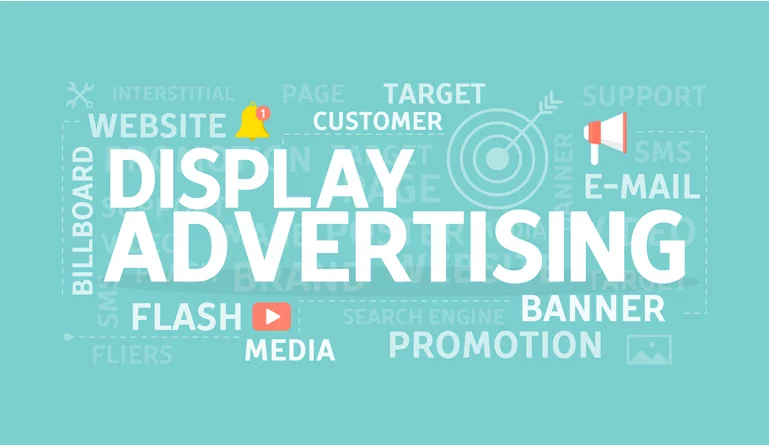On October 27, 1994, the first banner advertisement was posted on a tech website called Wired. Long story short, AT&T paid Wired $30,000 for a three-month subscription to their banner ad. As a result, the click through rate was 44%, being higher than today’s average click through rate, which is typically around 0.5%. I guess we can say that this story was how display advertising made a breakthrough in the marketing industry.
- Display Advertising Definition
- How Display Ad Works
- Why is display advertising an effective acquisition channel
- Display Ad Metrics
- Types of Display Advertising
- Benefits of Display Ads
- Downsides to Display Ads
- Display Advertising Strategy to consider
- Display Ads examples
- Display Ads Platforms
- FAQs
What is Display Advertising?
You’ve seen them everywhere. Animations, logos, photographs, GIFs, you name it! Display advertising is a form of online advertising where advertisers seek the opportunity in conveying a message through visual aids. This can also be known as, “banner advertising”.
How Display Advertising Works
When it comes to search results, display ads will not show up due to how it functions.
Now, why is that? Well, the next time you look at a display ad, notice how the banner ads on a website feature promotional interactive displays. Sometimes, these display ads feature random things that might have been a part of your search history! However, in hindsight, these types of ads are not the easiest visuals to be found on the internet. Hence, the different functions of display ads.
Why is Display Advertising an Effective Acquisition Channel
If you think about, “how do businesses attract consumers?”, consider these two main reasons that will help you out.
-
“Thank you, come again!”
Display advertising is seen as an effective acquisition channel because every business needs to get the attention of every customer. It’s important to create solutions to get a consumer to buy a product and also make sure that they come back again the next time around. After all, customer loyalty is one of the important aspects to having a good brand for your business.
-
Visual appeal
A picture is worth more than a thousand words. Yes, in this case, all it takes is the big picture of your product. Don’t be afraid to be creative with your promotional strategies, especially when it comes to coming up with visuals for ad campaigns. Engagement is key when it comes to instantly getting the attention of your audience.
Display Advertising Metrics
Analyzing the data behind display ads is another essential to consider when using display advertising. The following metrics that you need to have when using display ads are: reach, click through rates (CTRs), bounce rates (BCRs), conversion rates and return on investments (ROI). For more information about metrics, please read “25 Key Advertising Metrics Digital Marketers Should Track”(1). You won’t regret it.
What are the main types of display advertising?
Aside from the typical banner advertisements that can be seen on web pages, display advertising has grown a lot since then. Here are the following types of display advertisements.
- Re-marketing Ad: This type of ad can help you boost up your ROIs. This is considered a powerful tool for display ads because it allows businesses to keep in touch with past website visitors.
- Website Placement: Probably the most effective and safest option for targeting your audience. Website placement lets you choose what kind of websites that you can place your ads on rather than letting Google suggest sites to place your ads in for you.
- Target by Interest: You can use your ads based on the types of interest categories that search engines, such as Google, have to offer. In this case, two types of audiences that you would reach out to would either be in-market audiences or affinity audiences. The difference between the two is that in-market audiences cater towards people who are willing to buy products as soon as possible, whereas affinity audiences are people who are inactive and considered “long-term interest” users.
- Contextual Targeting: Displaying ads through contextual targeting is the equivalent to Search Engine Optimization (SEO). This is because contextual targeting helps you with your display advertising through the use of keywords. The keywords find relevant websites to display your ads on.
- Topic Targeting: A strategy that can assist in choosing specific web pages where you can display your online ads on. Think of this as a smart tool that allows you to choose the most relevant topic that your display ads will be able to fit into.
Benefits of Display Advertising
Now, here are the perks of display ads.
- Re-marketing: The good thing about display ads is that it can allow more opportunities to remarket your brand. With re-marketing, display ads allow your business to become targeted by defined audiences that have previously visited your company’s website. The more views that your display ad gets, the increase in potential purchases of your product is likely to happen.
- Better Engagement: Another perk that you can benefit from display advertising is having the ability to track and monitor your ad’s engagement. This will provide insight to how your display ad is being reached by your audience as well as create strategies that can help improve future display ads.
- Affordability: If you think about it, having a display ad promoting your business or company is pretty affordable than having television or radio ads. Because TV and radio are mediums that require large investments, your company or business can save a lot more money when it comes to display ads.
- Visual Appeal: Not to just state the obvious, but yes. Visual aesthetic through your display ads is quite a benefit to display advertising. It can be an interactive display ad of your brand or a quirky little slogan from your campaign. Either way, visual aid is one way to get your message across to consumers.
(Download Whitepaper: What Is Programmatic Advertising and Why Is It Important?)
Challenges of Display Advertising
Although there are benefits to having display ads, there are also setbacks that come along with it.
- Engagement: Yes, this can also be challenging for display ads. Even though you get to monitor your engagement, sometimes there is a lack of reach for impressions. Based on a 2014 study conducted by Google, at least 56% of ad impressions are not seen.
- Irrelevant places: There are times where your display ad will end up in unexpected places. The challenge with display ad placements is keeping up with automatic publishing of where to place your display ad.
- Timing: Another challenge is finding the time for display ads. Keeping up with finding time slots and when to release your display ad can be difficult due to constant monitoring. All of your display ads should be monitored on a daily basis in order to prevent your ad placements from getting out of control.
- Consistency: With brand imagery, you must keep consistent with your display ads. The more irrelevant your topics become towards your brand, the less engaged people will become. Maintaining that consistency towards your brand is something to keep in mind when creating display ads.
How to set up display advertising strategies
Here are a few things to consider before planning out campaigns for your display ads.
- Set up your campaign goals: Write down what are the most important things to execute during your campaign. Think about all the points that need to be discussed and how will you make it a priority for your audience.
- Choose the right tools to execute your campaign: Make sure that the right platforms you’re using fit into your company as well as the campaign. Also consider media buying or a media agency as other alternatives if you do not want to move forward with using a platform.
- Think about how you want to reach out to your audience: This is one of the biggest decisions that you have to make when marketing your business. There are a variety of strategies that you can choose from to make your campaign successful depending on your brand.Just remember the general types of places that you can reach out to:
- Location
- Demographic
- Retargeting
- Optimize your landing page: Use your display ads as a guide for users to enter your business’s landing page. You want to apply your brand’s message onto your display ad to not only increase viewership, but also conversion rates and ROIs.
- Leave a compelling message: Create a message in your ad that will make people say, “Oh yeah, I remember that ad!”. Make catchy phrases or clever puns for your ad.
Display Advertising Examples
-
Coca-Cola: Making People Feel Good Campaign
Coca-Cola featured interactive ads with a call to action button that would allow users to send a can of Coca-Cola to a random stranger anywhere in the world. This was inspired by Coca-Cola’s Hilltop ad and helped the brand establish the idea of web-enabling vending machines!
-
Apple’s Display Ad Campaign
Since 2007, Apple has been creating display ads that simply feature high quality photos of Apple products. The key point to Apple campaigns: “less is more.” Because of this tactic, Apple has become the simple and sleek brand that we know it as today.
-
Mailchimp: “Did you mean Mailchimp” Campaign
Wordplay and audience interpretation were one of top ways Mailchimp execute this campaign. They chose phrases that rhymed with their brand Mailchimp and became creative with the overall concept that sparked interest for anyone that landed on their company’s landing page.
Display Advertising Platforms
Another way that you can set up display ads is through ad networks. The following softwares can easily assist you with advertising inquiries.
- Google AdSense
- Facebook Audience Network Ads
- Apple Advertising
- Adknowledge
- Yahoo! Network
- Taboola
- Epom
- Airpush
- Leadbolt
Even though these are the top ten platforms to use for display advertising, don’t let yourself stop here. You can learn more insight about more platforms from 10 Best Display Advertising Networks for 2020
Frequently Asked Questions about Display Advertising
Q. What does the word “placement” mean when planning my display advertisement?
A. Placing your ad in the right spot is a big deal. When making placements for your ad, you must find the exact location of your ad on a certain page of your website.
Q. What’s the difference between display and native advertising?
A. Native ads are known as “recommended content” that pop up into your feed or search engine results. They attempt to mimic articles and pages that surround it. With display ads, it’s just a traditional banner ad that’s used to promote your product or brand. Therefore, it clearly serves a different purpose than native advertising.
Q. Search advertising vs. Display advertising
A. Search ads only appear when you use a search engine, allowing it to appear in your results. Search advertising typically caters to a local market and provides short sales cycles that trigger urgent needs of potential customers that need a business’s service.
Display ads fill up the ad spaces on websites. Unlike search ads, display ads cater to niche or luxury buyers, and use more photos and videos to promote a product. Display ads have a longer sales cycle and focus more on building brand awareness with consumers.
Q. How much does it cost to work with an ad agency?
A. Typically, it can range up to the thousands when working with an ad agency. However, it solely depends on what kinds of services you’re looking for in terms of marketing your business. For example, if you want an ad agency to work on social media marketing, then you would be looking at $15,000 per month.
At the end of day, when hiring an ad agency, you want to find the biggest bang for your buck because every business wants to have a high-quality image with high quality advertising.
Q. Why should I include display ads in my marketing campaigns?
A. This can increase your potential with your return on investments (ROIs). Display ads give you more access to increasing awareness for your brand as well as ring in more engagement from your target audiences.
Final Thoughts
When maximizing display advertising for your business, just remember the significance behind every product that’s being promoted through this type of marketing. First thing’s first: Always be creative. Creativity is important during this process because you need to have that sense of visual appeal for your audience. Just think about how you can grab the attention of someone in just a few seconds in order to make a bigger difference towards your work.
The second piece of advice to remember is choosing the right platform for your brand. There will always be a platform for every company. You just have to find the right fit for your display advertisements. Consider social media platforms when increasing strategies. Lastly, keep in mind all of the analytics behind your ad.
Keeping track of the numbers on a daily basis will assist you in optimizing your goals and pave the way for improvements that you can make with display advertisements overtime.
***
Aileen Padua is an aspiring social media coordinator. She is currently majoring in Advertising at Fresno State University. With her understanding of the power of social media, Aileen is passionate about preserving and enhancing the image of one’s reputation in the public eye.








